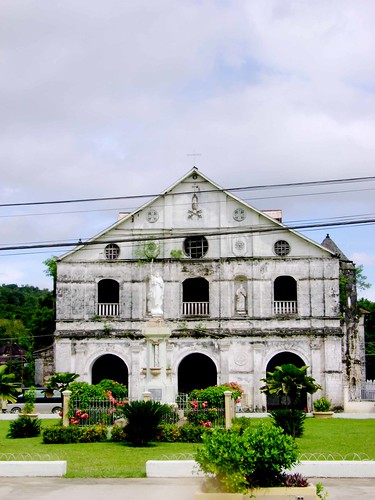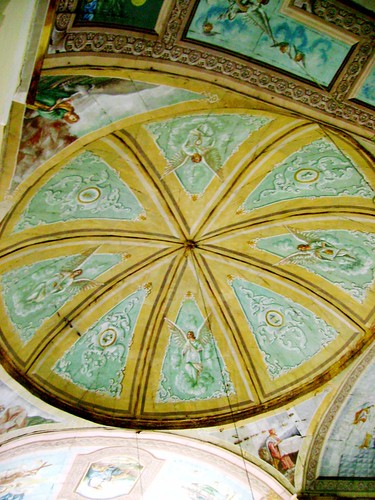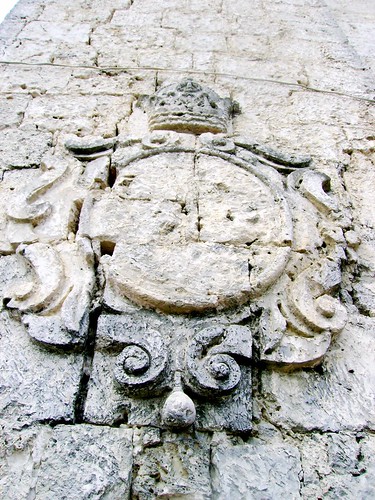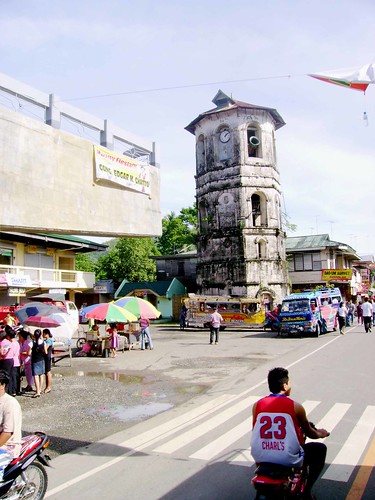The buses going back to Tagbilaran are few and rare, I don’t know if it was because it was high noon, but I waited for some 30 minutes. When a bus finally came, it was jam packed! So full that I was tempted to ride on top of it, (upon the suggestion of the conductor) but decided not to, I was worried that it might rain (I had my laptop & camera) I joined the rest of the passengers inside.
It was hot and there was hardly space to move, it was far from comfortable but this is how regular folks here commute - I enjoyed the ride even though it was a hot day. The bus was overloading passengers that when we were entering the steep passages of Bilar a tire went flat!
As the bus descend to the lowlands, I was already dreaming of the buffet I plan to have in Loboc, while on board the barge that would cruise the river. I was very hungry from all the walking. But before doing the cruise, I decided to walk around Loboc.

The beautiful Church of San Pedro Apostol, I found bas relief's of the Papal tiara, Jesuit symbols and the Spanish coat of arms around the church.
Reaching Loboc I went to see some of the Tarsier’s, I didn’t enjoy this experience, I felt bad about this beautiful animals being caged near the riverside. I just can’t take pictures of this little creatures knowing that their being used just for profits. I should’ve visited the Tarsier sanctuary in Corella but there was not enough time.
I then went to the poblacion where Loboc’s historic church and where the renowned river cruise starts, there’s an interesting structure here, probably one of the most stupidest tax funded project that I’ve ever seen. I don’t know when it started but some idiot built a bridge headed straight to the church!
I’m sure that Loboc residents fought hard to preserve their church, they succeeded, the project was canceled and it’s a good thing that they did not brought it down. The half finished bridge now stands a reminder of how wasteful and brainless people our leaders can be.
I went to the church and visited its parish museum. Very few people know that Loboc is where the Jesuits moved their mission after the Moro raids in Baclayon, although still maintaining the church there they set up Loboc as their mission center, having it as the mission’s resedencia, making the town one of the most significant town in early Visayan Catholic history.
Loboc is the oldest parish in Bohol, the Jesuit fathers always possessing the desire to educate, founded a boarding school here for boys (making Loboc the first town to be extensively educated by the Spanish Jesuits). It was here that the Loboc natives were introduced to music. Today, Loboc is known for its music culture.
When the church was taken over by the Recollects upon the expulsion of the Jesuits, they renovated the church and built the impressive tower we see today standing.
Padre Alonso de Humanes, considered by many a holy man, who converted natives from Leyte and some other islands is said to have been buried here. I heard from someone that the Jesuit novitiate in Novaliches have the remains of this devoted Friar. Are they the same person? or was the body moved? I would need to ask around and research on this a bit I guess. Here in Loboc, it is said that his grave site use to be a popular pilgrimage, people believe that this man is a saint – with all his labors to propagating the faith and his record of admirable conduct – making him well loved and respected, I believe he must be.

The dome with its beautiful artwork.
The convent, now part museum part residence, is a three storey building. Much of it is unaltered which was truly exceptional, the second floor often serves as a meeting place, kinda like a convention hall. The murals on the ceiling were done by Rey Francia and one Canuto Avila. Other interesting objects in the church are the retablos (from the Jesuits and Recollects) and the bas reliefs. All of which are in excellent condition.

A Bas relief with the symbols of Colonial Spain.
[

The bell tower and the discontinued stupid bridge.



No comments:
Post a Comment